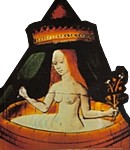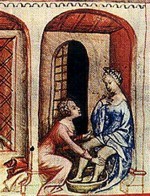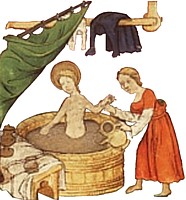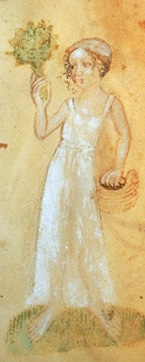|

beauty,
health &
hygiene
general
healthcare
skincare
cosmetics
& perfumes
body
hair
cleanliness
& hygiene tools
bathing
hair
care
hair
styles
oral
care
& dentistry
intimate
feminine
hygiene
|

Medieval
baths & bathing
BATHS - BATHING - BATHHOUSES
-
BATH ATTENDENTS
The general standard of medieval
cleanliness was considerably higher than Hollywood movies would
have us believe. The poorer person was just as concerned with
personal hygiene and cleanliness as the wealthy, perhaps more
so.
A person who worked with
animals or out in the fields all day would be more in need to
wash their hands and face before a meal than a person who had
not worked at manual labour. A lack of money and possessions did
not preclude the lowest classes from basic good hygiene.

Baths
What
did a medieval bath look like? Where did the water come from?
more to come
 Bathing Bathing
The Tacuinum sanitatis of Liege, folio 76, writes of the
virtues of bathing with Water of A Pleasurable Warmth:
Nature: Warm and humid
in the second degree.
Optimum: The kind that opens the pores with moderate heat
or with a fever.
Usefulness: For bodies with open pores; furthermore, it lowers
the temperature.
Dangers: for intestinal flow.
Neutralisation of the dangers: With astringent drinks.
Pictured above at the right
is a stained glass window section from the Labours of the Month,
June dated at the 15th century from Brandison Hall in Norfolk.
It shows a woman bathing in a large, canopied wooden tub. Bathing
was a part of the daily ritual. 
The peasant or lower class might swim or bathe in streams or wash
from a small basin and jug, whilst the wealthier would attend
public baths if they did not have one at their residence.
Pictured at left, is a detail
from a 14th century illuminated manuscript, Tacuinum Sanitatis
showing the benefits of Hot Water; two women washing the
lower legs in a shallow basin of water; the kirtle drawn back
up to the thighs. Hot water was highly recommended to combat coldness
in the limbs.
Due to the way medieval people utilised their household space,
a separate room was not usually set aside for the purpose of bathing
alone. The wooden tub would be brought to the room where it was
required along with the heated water and fragrant oils or soaps.
 Parkinson
recommended the addition of thyme, Thymus species, for
baths and strewing for its refreshing and sweet-smelling qualities.
Pictured at right is a detail from an illumination of Mary being
bathed by her servant from The Hague, KB, 76 F 21 fol. 15r.
A curtain provides privacy. Her clothes are hung on a pole nearby. Parkinson
recommended the addition of thyme, Thymus species, for
baths and strewing for its refreshing and sweet-smelling qualities.
Pictured at right is a detail from an illumination of Mary being
bathed by her servant from The Hague, KB, 76 F 21 fol. 15r.
A curtain provides privacy. Her clothes are hung on a pole nearby.
In the 14th century Boccaccio's
the Decameron we read about bathing-
Without permitting
anyone else to lay a hand on him, the lady herself washed
Salabaetto all over with soap scented with musk and cloves.
She then had herself washed and rubbed down by the slaves.
This done, the slaves brought two fine and very white sheets,
so scented with roses that they seemed like roses; the slaves
wrapped Salabaetto in one and the lady in the other and then
carried them both on their shoulders to the bed.
They then took from the basket silver vases of great beauty,
some of which were filled with rose water, some with orange
water, some with jasmine water, and some with lemon water,
which they sprinkled upon them. After which they refreshed
themselves with boxes of sweetmeats and the finest wines.

 Bath
houses Bath
houses
Types of bath house
Baths or stewes were almost
a popular pastime for the townsperson or noble. Scented bathes
might also include music, a meal or refreshment served on a tray
which reached from one side of the tub to the other. Stewes were
notorious for the other kinds of entertainment which could be
purchased from women of dubious morals. Prostitutes.
Bathers would be attended by men and women who would supply the
patron's needs. Although patrons bathed nude, headwear was still
worn to preserve modesty.
The church, whilst favouring
cleanliness of mind, body and spirit were very quick to denounce
public stewes as dens of iniquity and moral looseness, which it
seems, they often were.
The Paris Bathhouse Keepers
Guild had strict rules to follow. These included rules for
those not just washing, but hiring the services of a prostitute
while they were there. The general rules for baths and steam baths,
those who owned them and those who attended. These included:
Whoever wishes to
be a bathhouse-keeper in the city of Paris may freely do so,
provided he works according to the usage and customs of the
trade, made by agreement of the commune, as follow.
Be it known that no
man or woman may cry or have cried their baths until it is
day, because of the dangers which can threaten those who rise
at the cry, to go to the baths.
No man or woman may heat up their baths on Sunday, or on a
feast day which the commune of the city keeps.
And every person should pay, for a steam-bath, two deniers;
and if he bathes, he should pay four deniers.
And because at some times wood and coal are more expensive
than at others, if anyone suffers, a suitable price shall
be set by the provost of Paris, through the discussion of
the good people of the aforesaid trade, according to the situation
of the times.
The male and female bathhouse-keepers have sworn and promised
before us to uphold these things firmly and consistently,
and not to go against them.
Anyone who infringes any of the above regulations of the aforesaid
trade must make amends with ten Parisian sous, of which six
go to the king, and the other four go to the masters who oversee
the trade, for their pains.
The aforesaid trade shall have three good men of the trade,
elected by us unanimously or by a majority, who shall swear
before the provost of Paris or his representative that they
will oversee the trade well and truly, and that they will
make known to the provost of Paris or his representative all
the infringements that they know of or discover, and the provost
shall remove and change them as often as he wishes.
Those for a more personal
encounter in the baths, regulations stipulated that:
No man or woman of
the aforesaid trade may maintain in their houses or baths
either prostitutes of the day or night, or lepers, or vagabonds,
or other infamous people of the night.
Of course, we all know, buy
contemporary word and depictions in art, that this was roundly
ignored.

 Bath
attendants Bath
attendants
Enjoying your bathing experience. more to follow

Copyright
© Rosalie Gilbert
All text & photographs within this site are the property of
Rosalie Gilbert unless stated.
Art & artifact images remain the property of the owner.
Images and text may not be copied and used without permission.
|